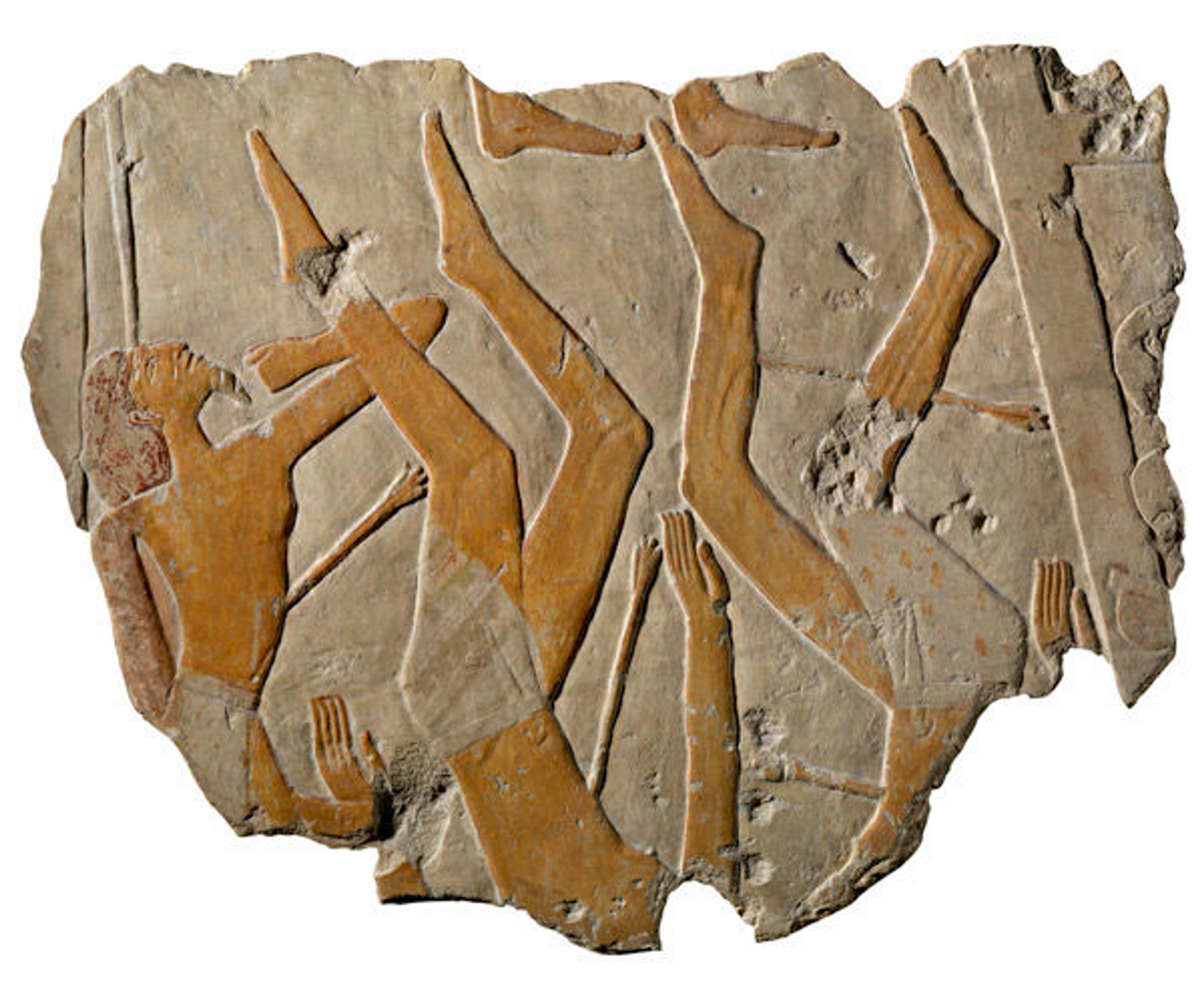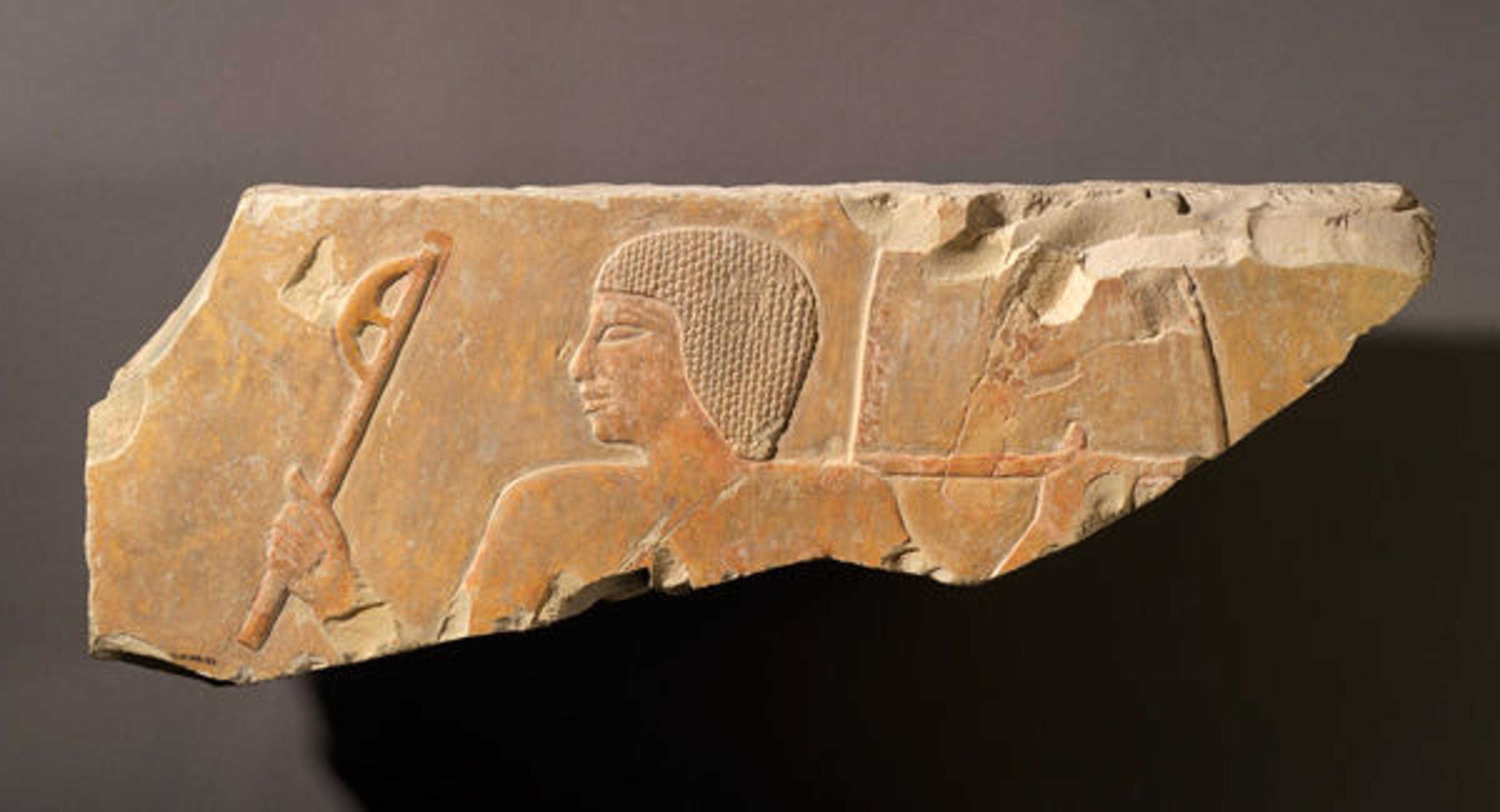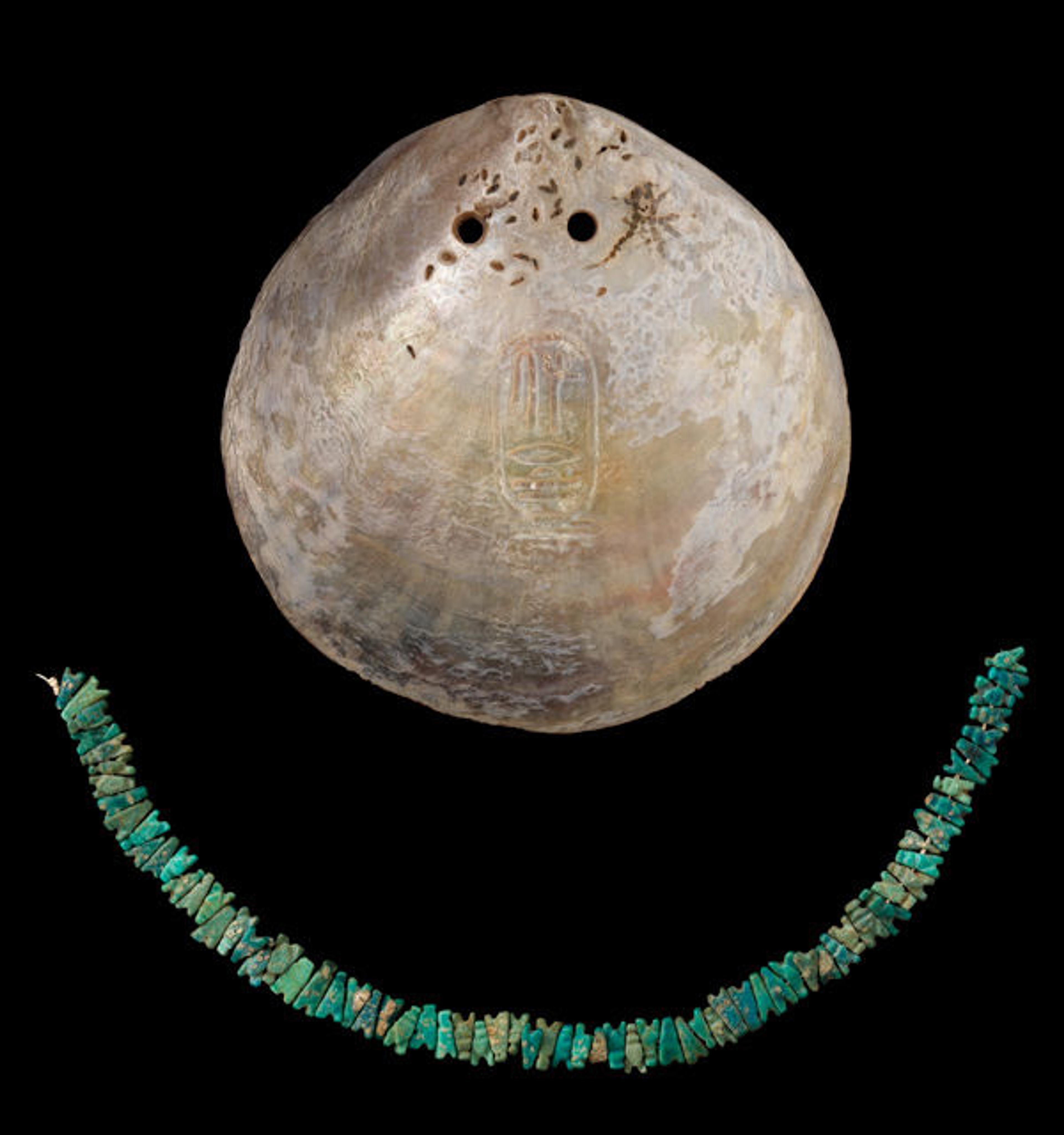In Honor of Pharaoh's Fighters

Fig. 1. Relief of foreign defenders falling from a fortress. Middle Kingdom, Dynasty 11, reign of Nebhepetre Mentuhotep II (ca. 2030–2000 B.C.). Thebes, Deir el-Bahri, temple of Nebhepetre Mentuhotep II. Painted limestone; H. 60 cm (23 5/8 in.), W. 66 cm (26 in.). The Trustees of the British Museum, London (AES 732)
«Strength, bravery, and tenacity were among the qualities that ancient Egyptians valued in their soldiers, and the exhibition Ancient Egypt Transformed: The Middle Kingdom features many intriguing artifacts that these warriors probably used as well as some magnificent artworks depicting the pharaoh's fighters. When looking at the action-packed battle scene in this painted relief (fig. 1), for example, I can almost hear the metallic noise of crashing weapons and the shrieks of the falling enemies shot by the Egyptian archers' arrows. The relief once decorated the mortuary temple of King Nebhepetre Mentuhotep II (ca. 2051–2000), the founder of the Middle Kingdom period (ca. 2030–1650 B.C.).»

Fig. 2. Relief of a soldier with an ax. Middle Kingdom, Dynasty 11, reign of Nebhepetre Mentuhotep II (ca. 2030–2000 B.C.). Thebes, Deir el-Bahri, temple of Nebhepetre Mentuhotep II. Painted limestone; H. 16.5 cm (6 1/2 in.), W. 46.9 cm (18 7/16 in.). Royal Ontario Museum, Toronto (910.34.53). Photo © Royal Ontario Museum
Whether historical or idealized, the Egyptian battle against the Asiatics living in the area of modern Palestine and Israel is presented in an unrealistically one-sided manner. In contrast to the utterly devastated foreign defenders shown in the relief discussed above, Egyptian attackers are perfectly unharmed, as seen in this relief (fig. 2). One soldier is shown holding a large shield and a double-fenestrated battle-ax, a new innovation at that time.

Fig. 3. Battle-ax. Middle Kingdom, probably Dynasty 12 (ca. 1981–1802 B.C.). Bronze, restored shaft and lashing; total length: 64.1 cm (25 1/4 in.), W. 7.8 cm (3 1/16 in.), Diam. 2.5 cm (1 in.). The Metropolitan Museum of Art, New York, Rogers Fund, 1915 (15.2.5a, b)
A bronze ax from the Met's collection is similar to the one depicted in the relief (fig. 3). Slightly later in date, this classic Middle Kingdom battle-ax has a longer cutting edge that made it more suitable for slashing the enemy in hand-to-hand combat. In addition to combat scenes and weapons, this exhibition also features personal items that illustrate the daily life of military personnel such as ration tokens, which were shaped like bread loaves and incised with the amount of bread to which the soldier who owned them was entitled.

Fig. 4. Scarab of the overseer of the troops Sebeknakht. Middle Kingdom, Dynasty 13, reigns of Sekhemre-khutawi Sebekhotep I to Merneferre Aya (ca. 1802–1677 B.C.). Glazed steatite; L. 2.7 cm (1 1/6 in.), W. 1.9 cm (3/4 in.), H. 1.1 cm (7/16 in.). The Metropolitan Museum of Art, New York, Theodore M. Davis Collection, Bequest of Theodore M. Davis, 1915 (30.8.669)
Another personal possession in the exhibition is a small scarab—a beetle-shaped seal—carved with a short inscription that identifies its owner, Sebeknakht, as "seal bearer of the king, overseer of the troops" (fig. 4). Egyptologists think that the combination of these two administrative titles was the Middle Kingdom equivalent of the army general. The owner's name, Sebeknakht, means "Sobek (a crocodile god) is strong"—an appropriately ferocious name for a high-ranking officer.
Eager to expand Egypt's territories and to consolidate domination over neighboring foreigners, the Twelfth Dynasty kings constructed numerous forts. One of the most successful builders was Pharaoh Senwosret III (ca. 1878–1840 B.C.), who erected massive boundary stelae in Lower Nubia, south of Egypt. The ancient Egyptians considered valor an essential quality in their military, and in one of these stelae the pharaoh declares that "I have made my borders south of my fathers. I have added to what was bequeathed to me. . . . Aggression is bravery, retreat is misery. The true coward is the one who is driven from his border."
Khusobek, one of the soldiers who fought for Senwosret III, claims on his own stela, "Then members of the army engaged in fighting with the Asiatics. . . . My face was confrontational; I did not give my back to an Asiatic." Khusobek was later promoted and rewarded with one hundred men to serve him.

Fig. 5. Pectoral and fly-shaped beads. Middle Kingdom, Dynasty 12, probably reign of Senwosret I (ca. 1981–1802 B.C.). Deir-Rifa. Oyster shell, faience; shell: H. 9.5 cm (3 3/4 in.), W. 9.3 cm (3 11/16 in.); string of beads: L. 19 cm (7 1/2 in.); each bead: L. 0.7 cm (1/4 in.). The Manchester Museum, The University of Manchester (4207)
In the same way that modern soldiers are recognized with medals of honor, it is thought that exceptional military service was also marked in ancient Egypt by certain symbols. One possible example included in the exhibition is a pearl oyster shell that has been polished and incised with the name of a King Senwosret (fig. 5). Among approximately fifty other examples of similar shell pectorals bearing royal names, one was found in a burial with a dagger, another was discovered with an archer's wrist guard, and a third was found inside a fortress.
The archaeological context of the shell on display is also significant: It was excavated together with a string of tiny fly-shaped beads, and the annoyingly tenacious fly might have already symbolized military courage in the Middle Kingdom as it seems to have in a later period. All these pieces of circumstantial evidence seem to indicate a close relationship between these shells and military personnel in Middle Kingdom Egypt.
In honor of Veterans Day, The Metropolitan Museum of Art will provide free admission to all U.S. veterans and a guest on Wednesday, November 11, when some form of U.S. Veteran ID is presented at any Admissions Desk. Come to the Met and salute soldiers from four thousand years ago in Ancient Egypt Transformed: The Middle Kingdom, on view through January 24, 2016.
Kei Yamamoto
Kei Yamamoto, former Lila Acheson Wallace Research Associate and now Research Specialist at the University of Arizona, received degrees from the University of Pennsylvania (BA, 2001) and the University of Toronto (MA, 2002; PhD, 2009). As an Andrew W. Mellon Postdoctoral Curatorial Fellow at The Met, he participated regularly in the Museum's ongoing archaeological expedition to Dahshur. Kei has also excavated at Abydos and Tell Tebilla in Egypt. Before coming to the Met, he lived in Cairo and worked for the Grand Egyptian Museum Project.